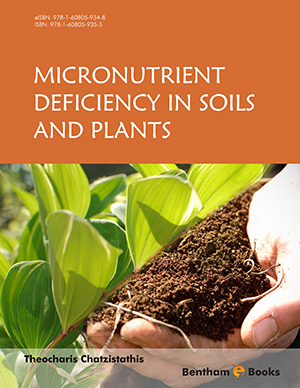Abstract
Despite the fact that Mn is one of the most abundant trace elements in the lithosphere, its’ concentration in soils greatly varies among soil types, depending on parent material and soil conditions. Apart from the parent material, other soil factors influencing Mn availability are pH, organic matter, soil moisture, CaCO3 content, redox potential, soil microorganisms, soil texture, the availability of other nutrients, the kind of N fertilizers (NO3- or NH4+) used by the farmers etc.
Manganese uptake by plants is metabolically controlled, i.e., it is absorbed as Mn2+, with energy consumption. In some cases Mn may be also taken up as chelate. Manganese is highly important for plant metabolism and growth, since it is contained in three enzyme complexes (those of photosystem II, MnSOD and acid phosphatases), while it is also an activator for a large number of enzymes (about 35). Manganese plays a very important role in photosystem II and photosynthesis, while it is also associated with the structure of chloroplasts, with N metabolism, with CO2 assimilation in C4 plants, with the cycle of tricarboxylic acids etc. Critical Mn deficiency concentrations for plant growth vary from 15 to 20 mg/kg d.w. (depending on plant species). The most characteristic symptoms of Mn deficiency are the appearance of small yellow spots on the leaves and the interveinal chlorosis. In cases of Mn deficiency symptoms, soil or foliar application of Mn (either as MnSO4 or MnEDTA) should be preferred. Particularly, foliar application of Mn is advantageous in calcareous/alkaline soils, where Mn is quickly immobilized after soil application.
Under conditions of Mn deficiency plants adopt tolerance mechanisms in order to survive. Some of the most important mechanisms include the acidification of their rhizosphere, the greater ability for remobilization and redistribution of Mn from the more to less tolerant tissues (such as the young leaves), the formation of arbuscular mycorrhiza to root system environment, the adjustment of root morphology in order to take up more Mn2+ etc. From an agronomical point of view, under conditions of limited Mn availability particular emphasis should be given to the choice and cultivation of genotypes with increased ability of Mn uptake and internal use efficiency (e.g., enhanced transport from the root system to shoot).
All these topics concerning Mn content and availability in soils, Mn uptake by plants, the role of Mn in biochemical and physiological reactions, the symptoms of Mn deficiency, as well as the strategies adopted by plants in order to survive under Mn starvation and the adaptation mechanisms of the Mn-use efficient genotypes are fully discussed in this chapter.
Keywords: Acid phosphatases, Mn availability, Mn deficiency, Mn fertilizers, Mn tolerance, Mn uptake, Mn utilization efficiency, MnEDTA, MnSOD, MnSO4, photosynthesis, photosystem II.






















